Exploring Surfboard Lights: Impact and Benefits
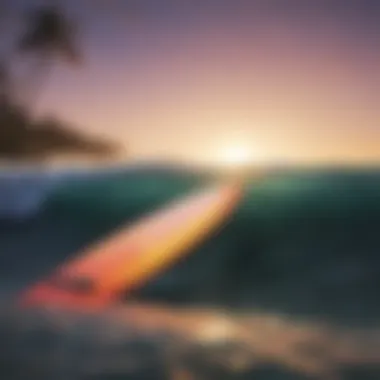

Intro
Surfing is more than just a hobby; it's a culture, a lifestyle, and for many, a passion that runs deep. However, the thrill of catching the perfect wave can often be overshadowed by concerns about safety and visibility, especially when the sun begins to dip below the horizon. Enter surfboard lights: a dazzling fusion of technology and creativity that aims to enhance the surfing experience. These lights are not just pretty decorations; they profoundly impact how surfers approach the sport, altering perceptions of safety and style.
As we ride the wave of technological progress, it’s essential to ask ourselves, How can surfboard lights transform our surfing adventures? From the bustling shores of Malibu to the more secluded surf spots around the globe, surfers are increasingly embracing these innovations. They help artists carve their unique marks in the twilight, using illumination not only to be seen but to stand out.
In this exploration, we will dive deep into crucial elements like the functionality and aesthetic appeal of surfboard lights. We’ll also look at different types available in the market, installation methods, and even environmental considerations that come into play. Furthermore, we'll hint at the potential limitations and upcoming trends to watch out for in the surfing culture. This comprehensive guide seeks to connect you to the vibrant world of surfboard lights and how they enhance riding in low-light conditions. Join us on this illuminated journey as we unpack the enchanting interplay between light and wave.
Prelude to Surfboard Lights
In the ever-evolving world of surfing, the integration of technology into traditional practices brings forth a new realm of possibilities. Surfboard lights are becoming increasingly significant for surfers who enjoy the thrill of riding waves at dawn or dusk, or even under moonlit skies. These lights serve not just to illuminate the boards but also to enhance safety and visibility, responding to the pressing need for better lighting conditions as surfing gains popularity beyond standard daylight hours.
Lights on surfboards aren’t merely a flashy gimmick. They are practical tools that help surfers stand out in crowded waters and reduce the chances of accidents, particularly during low-light conditions. With the right lights, adventurers can ride into the twilight of the day, pushing boundaries previously thought impossible.
Definition and Purpose
Surfboard lights are specialized lighting fixtures designed to be affixed to surfboards for enhancing visibility during nighttime or low-light surfing sessions. Their primary purpose is to ensure that surfers are seen by others in the water, significantly reducing the risk of collisions with boats or other surfers. In addition to improving safety, these lights bring a vibrant aesthetic to each ride. Surfers can now add a personal touch by choosing colors and styles that represent their character while riding the waves.
Additionally, surfboard lights can serve multiple functions; they can accentuate the surfer's presence for photography or social media posts, capturing stunning visuals that highlight the sport's beauty in dim environments. This role of surfboard lights is a game-changer in how surfers share their experiences with others.
Historical Context of Lighting in Surfing
Light has played a role in various water sports for many years, primarily from safety and visibility perspectives. Traditionally, surfers relied on natural light and reflective gear to be seen. However, as surfing grew in popularity, so did the challenge of visibility in the evening hours or during poor weather conditions.
Back a few decades, fluorescent paint and small battery-powered lights started making their way onto boards, mainly as novelty items. But they paved the way for more advanced solutions we see now— LEDs clever technology has transformed the concept of surfboard lighting. Today, LED lights are energy-efficient, longer-lasting, and available in multiple styles, allowing surfers to modernize how they interact with the water.
The push towards innovative surfboard lights reflects broader cultural shifts as more people embrace surfing as a lifestyle during various Zeiten. The idea of night surfing is gaining traction, creating a subculture that thrives under the stars and neon lights of surf spots around the world.
In summary, surfboard lights are steadily integrating into the surfing experience, improving safety, fueling creativity, and allowing surfers to explore new horizons. The historical context paints a vivid picture of how necessity and innovation create new opportunities, making night surfing not just a possibility, but an exhilarating adventure.
Types of Surfboard Lights
Understanding the various types of surfboard lights is crucial for anyone looking to enhance their surfing experience. Each type offers unique advantages and can be tailored to different preferences and needs. The growing popularity of surfboard lights isn’t just a passing trend; it’s about optimizing visibility, safety, and personal style. Let’s delve into the specific types available, keepin' in mind how they affect surfers today.
LED Surfboard Lights
LED surfboard lights have carved out a significant niche in the surfing community. Not only are they energy-efficient, but they also boast incredible brightness that can cut through the darkness like a knife through butter. What’s more, their durability stands out. With most models being water-resistant and long-lasting, they withstand the rigors of ocean waves and salty air without losing their sparkle.
The real kicker? They come in a variety of colors and brightness levels, allowing surfers to choose based on personal taste or visibility requirements. Many models even feature multiple settings! This adaptability means that you can easily switch from a soft glow for a mellow evening ride to a sharp, bright light when you’re navigating tricky conditions.
Neon and Glow-in-the-Dark Options
For those who appreciate a more nostalgic feel, neon and glow-in-the-dark options might strike a chord. Neon lights offer a vibrant, retro aesthetic, making any surfboard a statement piece in the water. Imagine surfing at dusk, the soft glow tracing your movements, adding an artistic flair to your ride.
Glow-in-the-dark options, on the other hand, rely on light-absorbing materials, providing a low-key yet effective way to stay visible. They take a bit to charge up, but once they get going, the soft luminescence can be captivating. Although they may not be as bright as LEDs, they off a unique charm that some surfers truly cherish, blending functionality with style.
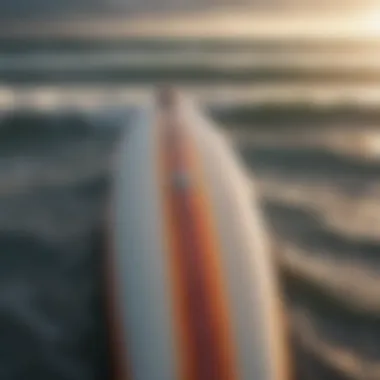
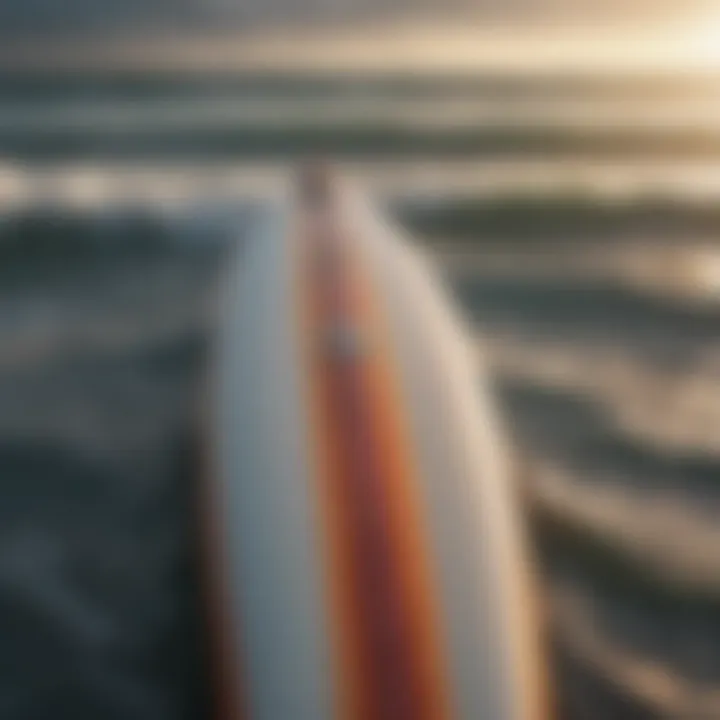
Solar-Powered Solutions
Solar-powered surfboard lights present an innovative twist for eco-conscious surfers. These lights harness the sun’s energy, making them not just a bright choice, but a green one too. They’re perfect for those long surf trips where charging via traditional means might be a challenge.
Installing solar-powered options might require a bit more setup upfront, but the reward is well worth it. Imagine paddling out at dawn, knowing your lights are powered by nature itself. Plus, they reduce reliance on batteries, making them friendly not just for your wallet, but also for Mother Earth. On the downside, they may not shine as bright as their LED counterparts, but they make up for it in sustainability—a win-win for the environmentally conscious surfer.
In summary, each type of surfboard light offers distinct features and benefits. Whether it's the practicality of LED, the nostalgic charm of neon, or the eco-friendliness of solar-powered solutions, surfers have plenty of options to enhance their visibility and overall experience in the water. Finding the right type that resonates with your individual style and needs can make all the difference.
Benefits of Surfboard Lights
Surfboard lights might seem like a quirky addition, but they are a game changer for those who enjoy riding the waves during the twilight hours or even at night. The dark waters can be as beautiful as a picturesque sunset, but they carry risks. Here, we unpack the benefits that surfboard lights provide, focusing on three main aspects: visibility and safety, aesthetic enhancement, and maximizing surf time.
Improved Visibility and Safety
Imagine paddling out just as dusk envelops the ocean. It’s a fantastic experience, but visibility can quickly deteriorate. Surfboard lights play a pivotal role in ensuring that surfers are seen by each other and any nearby vessels. The bright glow can be a beacon in the dark, making surfers more distinguishable against the vibrant hues of the water.
Visibility goes hand in hand with safety. According to studies conducted by marine safety organizations, the use of lights significantly reduces the risk of collisions. Surfers equipped with innovative LED lights are better able to gauge their surroundings, making them less likely to be caught off guard by sudden waves or unexpected swimmers.
"A well-lit board can mean the difference between enjoying that night surf and a harrowing experience."
Enhancing Aesthetic Appeal
Let's be honest—who doesn’t want to look good while carving through waves? Surfboard lights aren’t just functional; they add a layer of visual intrigue to the art of surfing. Riders can personalize their boards with different colors and light patterns, creating a unique signature style. Neon tubes or multicolor LEDs can make the surfing experience not only about riding waves but also about making a statement on the water.
The aesthetics become even more captivating during night sessions. Picture a group of surfers glowing amid the dark ocean, leaving rippling trails of light behind them; it’s almost otherworldly. This visual appeal can enhance not only individual experience but also attract spectators, transforming surf sessions into community events that celebrate creativity.
Maximizing Surf Time
For the die-hard surfer, the day doesn't end with sunset. Surfboard lights allow enthusiasts to catch waves long after the sun dips below the horizon. While others head to shore, light-equipped surfers can be out for hours more, hammering away at that elusive perfect wave.
Longer evenings can offer unique surf conditions, as the wind often calms and waves become less crowded. Surfers can harness these less frenetic times to hone their skills or simply enjoy the solitude that night surfing provides.
In summary, the benefits of surfboard lights extend well beyond mere illumination. They enhance safety, elevate aesthetic value, and extend valuable surfing opportunities, making them an indispensable addition for many surfers today.
Installation Process for Surfboard Lights
Installing surfboard lights is a crucial step that not only enhances the functionality of a surfboard but also increases the overall experience for surfers. The ability to surf at different times of the day and under varying light conditions can be greatly improved with proper installation.
When done correctly, the installation of surfboard lights ensures safety while maximizing visibility during night or low-light surfing sessions. Beyond that, the meticulous application of these lights can effectively influence a surfer's personal style and make a memorable statement on the waves.
Whether you're a seasoned pro or just starting, knowing how to install surfboard lights can save you from headaches down the line. Let’s dive into the necessary components to get started.
Required Tools and Materials
Before heading into the installation process, it’s essential to gather all necessary tools and materials. Here's what you usually need to get rolling:
- Surfboard lights (LEDs, neon, or solar-powered options)
- Adhesive (preferably waterproof)
- Power source (like batteries or rechargeable options)
- Wires and connectors (if applicable)
- Cutting tool (for trimming wires or adhesive strips)
- Protective gear (gloves and goggles, safety first)
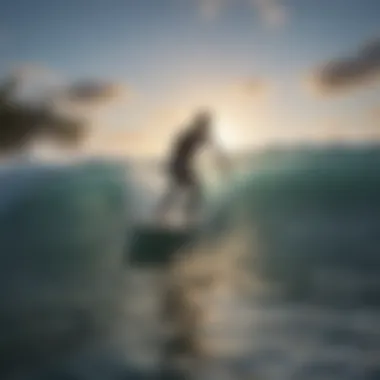

These items not only ensure that the installation is straightforward but also make certain that your lights remain securely attached under water pressure and adverse conditions.
Step-by-Step Installation Guide
Now that you have all tools and materials ready, let’s go through the installation process:
- Prepare the Board: Make sure the area where you plan to affix the lights is clean and dry. A smooth surface guarantees better adhesion.
- Plan the Layout: Before making any attachments, visualize where the lights will go. Consider both functionality and aesthetic preferences to create a balanced look.
- Secure the Lights: Apply your chosen adhesive to the back of the surfboard lights. Press down firmly in the desired locations, ensuring they adhere well to the surface. Be generous but careful with the adhesive.
- Connect Power: If using battery-powered lights, make sure all connectors are securely joined to avoid any disruption in power supply. With solar-powered solutions, ensure the solar panel is clearly exposed to sunlight.
- Test the Setup: Once everything is attached and connected, it’s crucial to test the lights before heading to the water. This will help identify any issues that may require fixing.
- Allow to Cure: Wait for the adhesive to fully cure. Refer to the manufacturer’s instructions, as this is vital to ensure they're securely attached before tallying your first ride.
Following these steps carefully can make or break the effectiveness of your surfboard lights. They set the stage for a nighttime surf that’s as thrilling as it is stylish.
Common Installation Challenges
Even with the best planning, challenges can arise during installation.
- Adhesive Failures: Sometimes the adhesive may not hold in the water pressure during surfing, which can result in damage or detachment. Using high-quality waterproof adhesive can help mitigate this risk.
- Incorrect Wiring: For lights that require electrical connections, improper wiring can lead to malfunction. Always double-check your connections and follow specific guides for your light type.
- Positioning: If the lights are not ambitiously positioned, surfers might find them casting glare into their own eyes or creating shadows that lessen visibility instead of enhancing it.
Environmental Considerations
The shift towards surfboard lights has raised significant questions related to environmental sustainability. Surfers are often viewed as stewards of the ocean, and the introduction of artificial lighting can influence their impact on marine ecosystems. An examination of the materials used in surfboard lights and their effects on marine life is paramount for anyone passionate about surfing and the environment.
Sustainability of Materials Used
A vital consideration when selecting surfboard lights is the sustainability of the materials involved in their manufacture. Many modern lights are made from durable materials like polycarbonate and aluminum. These materials can enhance the longevity of the products, resulting in fewer replacements over time, which translates to a lower environmental footprint.
Surfboard lights now often incorporate LED technology, known for its energy efficiency and lower heat emission. Unlike traditional incandescent bulbs, LEDs can offer the same brightness while using significantly less energy. Moreover, several brands are increasingly prioritizing recyclable components in their designs. For example, some surfboard lighting kits are crafted using biodegradable plastics, ensuring that at the end of their lifespan, they won’t contribute to ocean pollution.
"Choosing eco-friendly surfboard lights enhances not only your visibility but also demonstrates your commitment to marine conservation."
Impact on Marine Life
Considering the presence of surfboard lights during nighttime surfing also prompts an evaluation of their impact on marine ecosystems. Many marine biologists warn that artificial lighting can disturb the natural behaviors of marine creatures. Certain fish species and sea turtles, for instance, rely on lunar cycles and natural light cues for navigation and spawning. The introduction of bright lights might alter their natural patterns and lead to unintended consequences, like disorientation.
However, the comprehensive design of modern surfboard lights is evolving. Manufacturers are becoming increasingly aware of these risks, with some exploring options for dimmable or low-intensity lights that mimic natural light levels, thus minimizing environmental disturbances.
In summary, as surfers enjoy the thrill of riding waves under the stars, being cognizant of the environmental implications of surfboard lights becomes crucial. It’s essential to prioritize sustainable products that take into account both performance and the preservation of our ocean environments.
Potential Drawbacks of Surfboard Lights
While surfboard lights can greatly enhance the surfing experience, it's crucial to consider the potential drawbacks they may bring. This section aims to illuminate some specific elements that might cause concern among surfers and circles surrounding surf culture. Identifying these drawbacks not only helps in making informed decisions but also allows for a deeper understanding of how such technologies align or clash with traditional surfing values.
Effects on Aesthetics and Tradition
The incorporation of lights on surfboards can modify how these beloved instruments of sport look. For many, a surfboard symbolizes an art piece, often reflecting its owner's personality and connection to the ocean. The aesthetic appeal of a surfboard has long been steeped in tradition, with glossy finishes, vibrant colors, and unique designs representing individual surfers' identities.
However, adding lights into the mix can stir debate. Some surfers suggest that lights create a clash with these traditional views. The glow from undersides or sides of boards can be seen as an invasion of this artistic expression. As much as some folks enjoy the modern flair, others may perceive these enhancements as diluting the essence of what surfing is all about.
The visual impact could influence not just individual style but how surfboards are viewed as a collective cultural emblem. There's a fine line between embracing innovation and safeguarding heritage. Furthermore, some surfers might feel that by using brightly lit boards, they are transforming the serene, natural atmosphere of twilight surfing into something more artificial. The natural beauty of dawn or dusk is indeed a part of the experience. Are we risking too much of this allure in implanting technology?
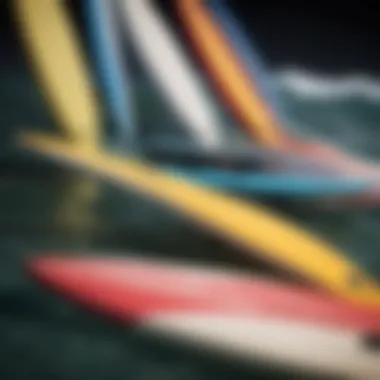
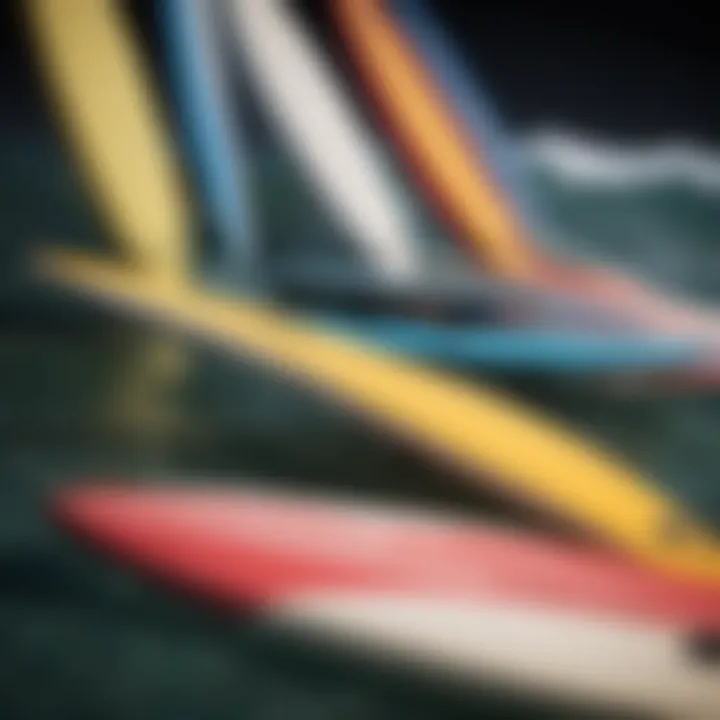
Cost Considerations
When it comes to integrating lights into surfboards, the financial implications are often overlooked. Generally speaking, installing surfboard lights involves certain costs that might not be trivial. The initial purchase of quality lights could set you back—not to mention the potential installation expenses if you're not inclined to tackle the task yourself.
Moreover, maintenance costs may arise. Depending on the light type—be it LED, neon, or solar-powered—some systems may require ongoing upkeep or battery replacements. This can add up over time, resulting in a financial commitment that might make some surfers pause, especially if they are already investing in high-quality boards.
In a world where many surfers prioritize environmentally friendly choices and sustainability, weighing the financial factor is essential. Being eco-conscious might shift some surfers’ considerations towards options that won't leech their wallets while serving a purpose. Some feel that strapping a few lights onto a surfboard seems like an unnecessary expense.
In summary, these drawbacks challenge the embrace of surfboard lights. While technology can elevate the experience, it’s critical to balance innovation with tradition, aesthetics, and long-term costs._\n
"These challenges compel surfers to think deeply about what they truly value in their craft and lifestyle."
In the end, understanding these drawbacks helps to foster a more nuanced appreciation for surfboard lights beyond their immediate benefits.
Future Trends in Surfboard Lighting
The realm of surfboard lighting is undoubtedly evolving, and its impact on the surfing experience cannot be overstated. Embracing these future trends means not just improving visibility but also redefining what it means to surf in harmony with both nature and technology. As we venture into the future, one cannot help but speculate about what lies ahead in the development of surfboard lights, considering various technological advancements, shifts in user preferences, and cultural influences that shape the surfing community.
Technological Innovations
Technology has always played a pivotal role in enhancing various aspects of surfing, and surfboard lighting is no exception. Recent innovations suggest a move towards more integrated systems that offer more than mere illumination. Think about sensors that detect low light conditions and automatically activate surfboard lights, ensuring surfers aren’t left in the dark. Moreover, developments in battery technology capable of extending operational time have gained traction. Nosak lights, for instance, have built-in batteries that can last several sessions on a single charge, which is a game changer for surfers who love the nighttime waves.
In addition to reacting to light levels, there’s a significant interest in developing smart lighting technology. Imagine surfboards equipped with Bluetooth features that sync with your smartphone, allowing customization of light patterns and colors according to mood or sea conditions. These trends indicate a shift toward a more personalized surfing experience.
"Surfboard lights could not only help with visibility but also transform your surfboard into a canvas of self-expression beneath the moonlight."
Growing Popularity and Culture
Alongside technological strides, there's a clear surge in the popularity of surfboard lights among surfers of varying backgrounds. More surfers are keen to explore after-dark sessions, driven by a desire for adventure, a change of scenery, and the thrill of conquering waves when others are asleep.
Surfers are forming communities around night surfing, participating in friendly competitions and social gatherings that celebrate this new culture. You’ll often find discussions on platforms like Reddit and Facebook about the best spots to surf at night, which light setups work best, and even sharing videos that capture the thrill and excitement of illuminated rides.
As visibility becomes more important, surfboard lights are also becoming a fashion statement. Brands and surfers alike are recognizing the aesthetic appeal of surfboard lights, leading to an explosion of colorful and stylish designs. From minimalist to extravagant, the variety allows surfers to express their individual styles while also prioritizing safety and functionality.
In essence, the future of surfboard lighting is not any one trend, but a melding of technology, community, and personal expression. Surge in production and innovation points toward a vibrant future where lights not only enhance the surfing experience but also encapsulate the spirit of adventure and camaraderie that defines the surf culture.
Closure
In the vast and vibrant realm of surfing, surfboard lights have emerged as more than just a flashy accessory; they represent a functional tool that enhances the surfing experience. This article has unpacked the many layers of surfboard lights, revealing diverse aspects like visibility, safety, and aesthetic appeal which are crucial for anyone riding the waves in lower light conditions.
Recap of Main Points
To sum it up, the key points discussed revolve around:
- Types of Surfboard Lights: Whether it’s LED lights providing bright illumination, neon options lending a psychedelic hue, or solar-powered solutions promoting sustainability, there’s a vast array of choices available for surfers.
- Benefits of Surfboard Lights: Improved safety cannot be overstated; brighter boards mean increased visibility for both surfers and others in the water. They also elevate the overall surf aesthetic, allowing surfers to express personality in ways traditional boards cannot.
- Installation Process: Understanding the right tools and procedures necessary for proper installation can save time and frustration, ensuring that lights are affixed securely and effectively.
- Environmental Considerations: Attention is drawn to sustainability, examining how materials and lighting choices impact marine ecosystems, which is key for environmentally-minded surfers.
- Potential Drawbacks: While discussing aesthetics and costs, some traditionalists may argue lights detract from the classic surf experience. However, the community is increasingly accepting of innovations that enhance safety and enjoyment.
- Future Trends: Technological advances paired with a growing culture around surfboard lighting suggest that these enhancements are here to stay, possibly leading to new designs and functionalities in the near future.
Final Thoughts on Surfboard Lights
Surfboard lights have transformed the way surfers engage with the water at different times of the day. Their versatility and utility serve as a reminder that surfing, much like any sport, evolves and adapts to meet new needs and preferences. With the growing popularity of night surfing and the increasing emphasis on safety, having the right lighting not only extends surf time but also contributes to creating a safer environment overall.
"In essence, surfboard lights are an intersection of technology, art, and function, bringing a whole new dimension to an age-old sport.”
For surfers, instructors, adventurers, and eco-enthusiasts alike, embracing surfboard lights is about enhancing the experience while being mindful of the environment. As the surfing culture continues to progress, these lights represent both innovation and passion, lighting the path for surfers who choose to carve their waves after sunset.















